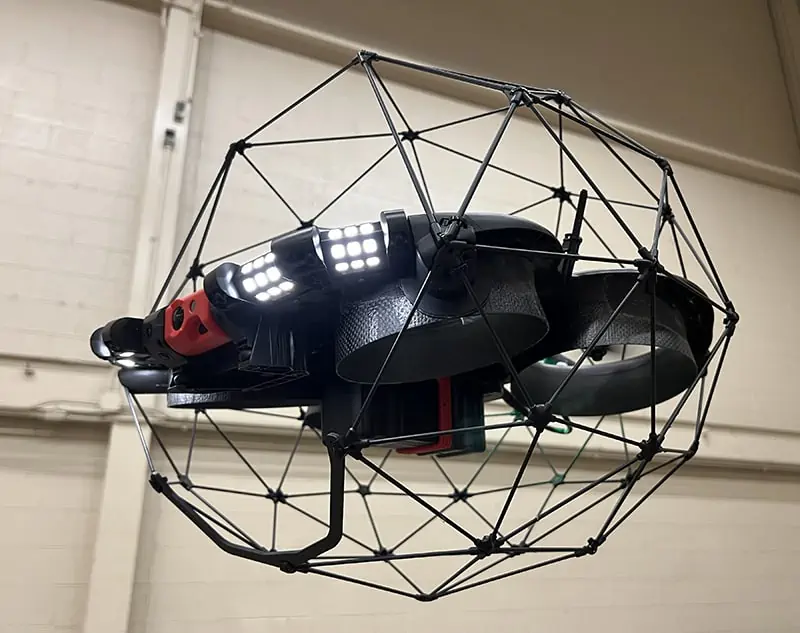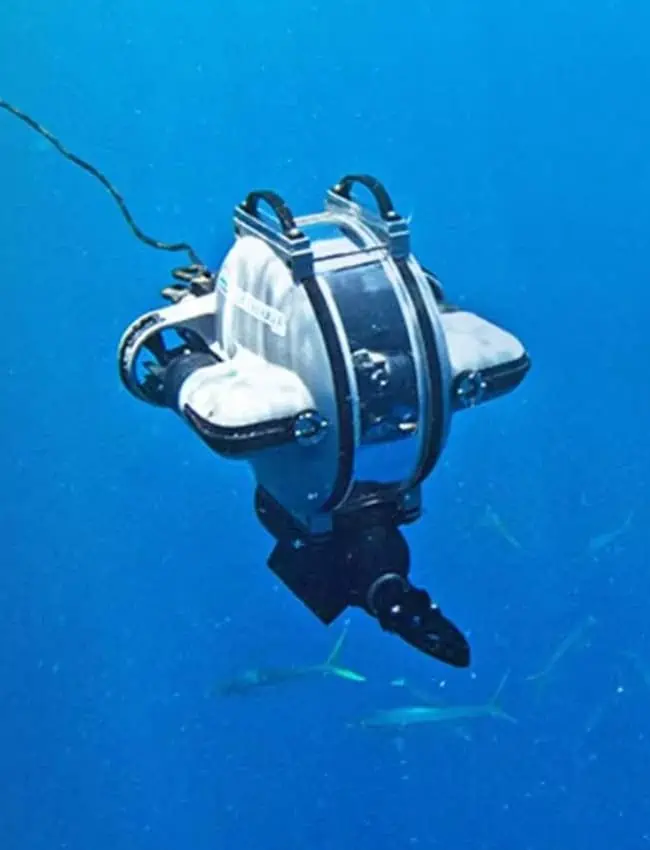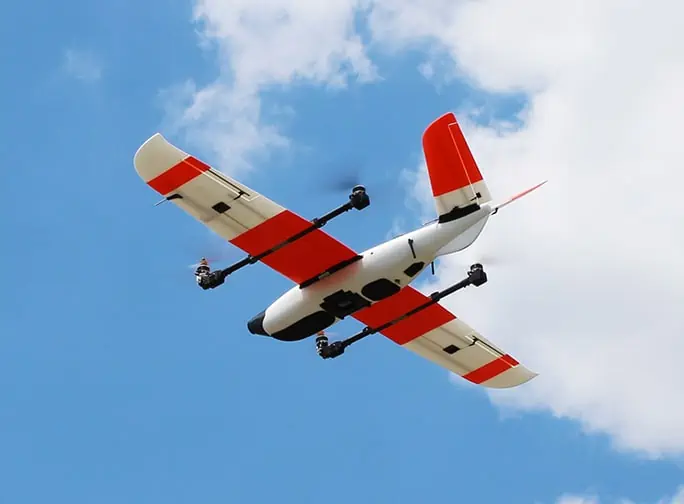Warren Community College’s nationally recognized Unmanned Systems training program offers advanced training to students looking to work within the drone industry. Below WarrenUAS students discuss the benefits of gaining hands-on experience with advanced unmanned systems such as Boston Dynamics’ dog-like robot SPOT, Censys Technologies’ fixed-wing drone Sentaero, and Deep Trekker’s DTG3 ROV (remotely operated vehicle).
Saad Abdelhady sounds like someone new to drones when he describes his experience with the broad array of technology available at WarrenUAS and the endless opportunities for their use in multiple career tracts.
“I’m really just getting my feet wet and finding out what intrigues me most,” says the first-year student at Warren County Community College, where some of the most sophisticated unmanned systems are being used by students in the fast-growing WarrenUAS (unmanned aircraft systems) program at the school.
But when Abdelhady focuses on two of the advanced systems he’s worked with at the college, it’s clear he’s quickly gaining an appreciation of the technology.
“Of the aircraft, one of my favorites is the DJI Matrice 300 RTK,” he points out. “For its size, it’s such a nimble aircraft, with carbon fiber landing gear and propeller arms it makes it feel as if you are flying a smaller aircraft. It’s very deceiving.”
Abdelhady has a special appreciation for SPOT, the college’s sophisticated, dog-like robot from Boston Dynamics that has gained a lot of attention walking up stairs and performing other elaborate tasks. He notes SPOT at WarrenUAS has been upgraded with a manipulator arm “that can open doors, close valves and perform other actions that increase its flexibility”. It also has sophisticated cameras for remote views, he says.
“It is one of the most interesting devices WarrenUAS has. I can see how useful it would be for the military, law enforcement or fire and rescue, for instance, with its ability to enter locations and provide situational awareness and take action in some cases before it is safe for a human.”
Tom Knibbs, a second-year student at Warren, has had a similar reaction to the technology offered in the program.
“My initial and continuing reaction to all the equipment and facilities at Warren has been one of amazement and just feeling like I’ve had great luck,” he says. “If a well-funded university had the resources we do, I would be thoroughly impressed, let alone a community college. I still can’t believe such a program, with all of this equipment exists, so close to where I live.”
He says WarrenUAS has some of the most sophisticated technology available. “I have been so impressed to have the chance to learn about the technology involved in these systems in detail – and then also have so many opportunities to operate them in real-world situations.”
Knibbs is interested in pursuing an unmanned systems career in either agriculture or in safety, potentially working in the National Airspace System and the Federal Aviation Administration. Abdelhady, meanwhile, says he has not yet decided what area he wants to specialize in within the drone industry.
WarrenUAS students are learning about the applicability of the variety of UAS systems in fields ranging from law enforcement and disaster warnings & relief, to entertainment and environmental study. Precision agriculture using drones is a field where Warren will soon offer specific specialized training.

AI and Robotics at WarrenUAS
Sai Sankar, teaching administrator for artificial intelligence and robotics at the college, says the mix of advanced technology allows students to explore a variety of applications for drones as the industry grows and reaches into nearly all segments of life.
He and Peter Miller, WarrenUAS unmanned systems specialist, both say that they’ve found it gratifying to work with students as they first learn some of the fundamentals about drone flight and safety. However, they say, providing students experience with the advanced systems is particularly rewarding.
“While it is so important for them to have all the fundamental knowledge and skills, it is exciting to see their reaction to these very sophisticated pieces of equipment – and then have an opportunity to use them,” says Sankar.
“We have some of the latest, cutting-edge technology, and we are constantly monitoring the industry so that our equipment stays current,” Miller adds. “Our students get what we believe is some of the best training in the country on the newest technology available.”
Sankar says he’s pleased with student interest in the DJI Matrice, which is the latest in the Matrice line of drones for industrial and commercial use. It has advanced artificial intelligence, is designed to be very wind resistant and can manage a variety of payloads, including sophisticated new Zenmuse H20 and H20T cameras. It has nearly an hour of flight time without recharging and a broadcast range of nearly 10 miles for video.
Abdelhady notes that he is particularly interested in its 360-degree obstacle avoidance technology along with its FPV and Zenmuse cameras.
“The Zenmuse has a thermal sensor, a LiDAR rangefinder, and a 200x zoom lens and is one of the most sophisticated sensors I’ve used.”
The popular SPOT robot has been valuable as a recruitment tool for the program, but Miller says it also offers students an opportunity to access a wide range of information about robotics and have hands-on experience with one of the most sophisticated and well-known unmanned devices currently made.
“We have a lot of cutting-edge equipment like SPOT and more of it than nearly any institution in the country. Beyond that, we have a nimble structure here where we can assess what are the most important new developments in the field and often acquire the technology. Then we can give students an understanding of it – and a lot of trigger time. That means they can go to an employer with very practical and marketable skills.”
Other high tech advanced UAS at the college include:
Sentaero – This fixed-wing drone from Censys Technologies It is particularly well suited to fly beyond the point where it is visible to the pilot, who is navigating through several video monitors inside its mobile command center, Sankar notes.
The company reports that the Sentaero offers an “extremely versatile platform that can be configured for many applications, including agriculture, mapping, search and rescue, pipeline monitoring, emergency response, infrastructure inspection and disaster relief.”
“This is one of the most advanced drones for flying beyond the line of sight,” Miller says, “making it very popular with utility companies or transportation systems,”. Warren is working with companies in both sectors.
WingtraOne – Sankar notes that the college has acquired two of these sophisticated fixed-wing drones, which are particularly valuable for mapping – gathering and processing information. They are eight times faster than traditional multi-rotor drones, according to the Swiss-based company that designed it, and twice as fast as most other fixed wing systems.
Sankar noted that such systems are in high demand in industries such as utilities, where accuracy and speed of data collection over a wide area is critical. It has among the greatest density, or sensitivity, to its sensors of any similar drones.

Deep Trekker DTG3 – The advanced underwater remotely operated vehicle (ROV) rounds out the college’s systems that work on land, the air and in the water. The Deep Trekker DTG3 is a tethered drone that can perform underwater exploration or inspection in harsh environments, Sankar says, to a depth of 656 feet with a battery that can last up to 8 hours.
The ROV at WarrenUAS will be put to use monitoring aquatic health in an area lake in a research project for students done in conjunction with biologists working for the lake association.
“The real-world experience I’ve had using the WingtraOne, DJI Matrice 300 and the Deep Trekker submersible is definitely preparing me for a career in the industry, as these are the exact same pieces of equipment used in the field,” Knibbs said. “I don’t have hands-on experience with the Sentaero yet but seeing it in action and knowing how difficult it is to obtain a BVLOS waiver (FAA approval of flying beyond where the pilot can see the drone) shows how capable this program is.”
Recon – This system allows students to build their own robots with a variety of capabilities, and Sankar and others at Warren have customized the equipment so that it allows for more sophisticated functions.
A key goal of Sankar’s is student awareness of the engineering behind the equipment they are using and an ability to maintain it. This customized “ground up” platform will give them a unique opportunity to see how each part of the system is designed, works together and functions in a finished machine.
In addition, such land-based drones that are developed can be used in a variety of circumstances where trained operators are needed, particularly law enforcement, where surroundings can be explored without risking an officer’s life.
Learn more about the acclaimed drone training program at Warren Community College >>



















